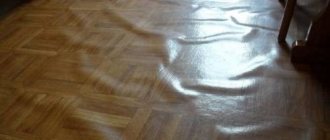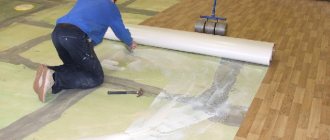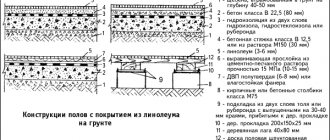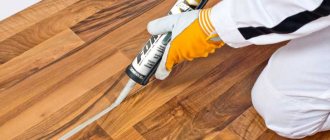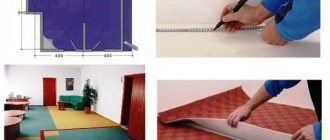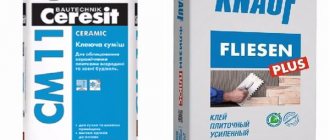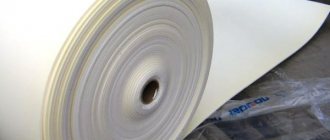Dispersive
This is an adhesive in the form of finely divided polymers in a liquid that can be used immediately after opening the package.
The main component of the substance is water. It is combined with various additives, such as:
- Acrylic, paint;
- Cellulosic acids;
- Chalk;
- Resin.
The composition has become widespread due to the following technical characteristics:
- High operating temperature – up to +15 degrees Celsius.
- Can be used for heated floors.
- 100% guarantees safety for humans.
- Increased level of adhesion.
- Durability and resistance to heavy loads.
It is important to know that the humidity in the room should not exceed 60%, and the temperature should not be lower than specified. Without following the operating rules, the material is destroyed beyond the possibility of restoration.
Common types:
| Representative | Compound | Where is it used? |
| Bustilat | Latex, chalk, carbomethylcellulose | For gluing felt-based linoleums. |
| Gumilax | Rubber, latex | For felt and synthetic coverings. |
| Acrylate | Thermoplastic resin | For homogeneously coated surfaces. |
Is it necessary to glue linoleum to the base?
Many craftsmen, especially when renovating residential premises, simply lay linoleum on the base without any fastening. Is it possible to do this? What are the advantages and disadvantages of gluing flooring?
Advantages of fixing linoleum over the entire base area:
- the tensile strength and wear resistance of the floor covering increases;
- the reliability of the connection of seams between the canvases increases;
- deformation of linoleum in the form of waves when moving heavy objects along the surface is eliminated;
- there are no swellings around the furniture legs;
- The service life, depending on the brand of linoleum, increases by 35-50% compared to an unfixed coating.
This is what linoleum looks like, which is not glued to the base, after several years of use.
The use of glue also has its disadvantages:
- Compared to laying on a dry base, fixation requires a certain amount of time for the glue to dry. The specific waiting period depends on the composition of the adhesive mixtures and the type of base material, more precisely, its hygroscopicity. For each brand of glue, the time for initial setting and complete drying (hardening) is indicated on the packaging. Thus, there is a technological pause in the work, since further repairs or furniture can be installed in the room only after the composition has completely dried;
- When using dispersion and reaction adhesives, it is necessary to prepare the floor perfectly evenly. Any defects will appear on the floor covering, if not immediately, then after a short period of use. When using bitumen mastics as an adhesive, minor defects on the surface of the base are allowed, which will be masked by filling the damage with the composition. But it should be taken into account that the cost of bitumen mastic is much higher than that of conventional dispersion adhesives.
Linoleum in the bathroom needs to be fixed; this will provide additional waterproofing and protect neighbors below from flooding.
Related article:
Which linoleum to choose for your home : types of flooring, sizes, markings, criteria for choosing the right room by room, tips and tricks - in our article.
Popular brands
The variety of adhesive compositions on the Russian market is great, but not all of them are of high quality. Among the companies that produce adhesives for linoleum, we highlight the following:
- Norme color profi - the company produces products for PVC linoleums. They are glued to substrates that absorb moisture onto the wet adhesive layer.
- Forbo eurocol - the company produces materials using Swiss technology. Forbo specializes in dispersion adhesives.
- Brozex - produces acrylic bases for gluing coatings on a felt, foam base.
- Ceresit produces conductive adhesives for antistatic linoleum. Ceresite provides precise bonding to a variety of surfaces.
- Pufas is engaged in the production of bases for commercial coatings. Pufas is completely ready for use after opening the can.
Glue consumption
The approximate glue consumption is always indicated on the packaging, but everyone can use a different application technology. For the calculation, you should take into account the type of base and the purpose of the glue. When studying the consumption of each product, you should take into account the lower limit, which will allow you to stock up on a certain amount of material.
To obtain the desired figure, you should multiply the glue consumption by the coverage area. For example, at a consumption of 0.4 per square meter with an area of 9 square meters, 3.6 kg of mixture will be required. If you buy reaction glue, then the consumption is indicated in grams per linear meter. The value is multiplied by the length of the seam.
The best means for gluing linoleum will be the one that suits most of the characteristics. It’s even better to buy mixtures that are used for a specific type of coating. Universal ones are no worse, but under certain conditions they can behave unpredictably. Some manufacturers produce linoleum and glue for it. The last option is most suitable, because then the materials are completely compatible with each other. When purchasing, it would be a good idea to consult with a specialist who will give useful advice.
Laying linoleum with glue (2 videos)
Types and uses of linoleum glue (33 photos)
Recommendations for selection and use
Experts recommend purchasing adhesive along with or after the floor covering to ensure that the adhesive composition is suitable. It is better to buy glue for linoleum in construction stores or large supermarkets where conditions have been created for its storage.
When choosing, it is important to pay attention to the type of finishing surface:
- Moisture-proofing substrate, old material - universal, silicone.
- Concrete is water soluble.
- Wooden floor - homogeneous compositions, PVA.
- Chipboard is a water-based product.
- Floors lined with stone, porcelain stoneware - reaction adhesives, moment.
- Plywood, wood covering - dispersion composition.
- Slab surface - mixtures with low water content.
Before starting installation work, you should wear rubber gloves.
If the surface under linoleum is uneven, the situation can be corrected with fiberboard slabs, which create a continuous base. The material absorbs moisture, so water-based glue cannot be used under it.
In order for the linoleum to adapt to the temperature of the room and lay down better, it is left for several days in a roll in the room where it is planned to be glued.
Then the linoleum is rolled out and left for several days until it takes on the desired dimensions.
Gluing the coating to a wooden floor
The general requirements for a wooden floor are as follows: the base must be clean, dry, and level. If there are gaps between the boards or sheets, they must be puttied. The linoleum roll is left indoors for 2 days at room temperature. To work you need to prepare:
- glue;
- roulette;
- putty knife;
- rubber roller or clamp;
- sharp knife;
- marker.
It is recommended to purchase linoleum strictly according to the size of the room - this will avoid joints and seams. Before gluing, trim around the perimeter, taking into account the architectural features of the room. At the same time, hold the cut part so that the coating does not tear, and place a board under the bottom. Pre-glue double-sided tape to plywood, OSB, and boards at a distance of 40 cm from each wall. This will help prevent the covering from moving when trimming. After a day you can start gluing. Before work, roll up a roll.
The procedure is almost the same as with a concrete base, but has the following features:
- at the edge of the roll, lubricate the wooden floor with glue - a strip 30 cm wide, while it is advisable to make the layer of uniform thickness, without bumps and grooves;
- apply the material to the smeared area, act accurately, since repeated rolling reduces the quality of gluing;
- move to the unfolded area, using a flat clamp to remove air from under the linoleum;
- inspect the surface of the material from different angles to completely eliminate the presence of bubbles;
- cover the entire room with strips of 30-40 cm, rolling out the roll;
- After the composition has hardened, you can glue the joints using “cold welding” or another method, and then secure the baseboards.
Terms of use
In order for the floor covering to last more than 30 years, it is necessary to strictly follow the installation technology. There are no universal rules, since each type of floor has its own nuances.
On the concrete floor
Before installation, the surface must be completely removed down to clean concrete. The final layer is cleaned and sanded, potholes and cracks are filled with putty.
Be sure to seal the joints between the wall and the floor. Small cracks are sealed with concrete mortar, large cracks are sealed with sealant or polyurethane foam.
The gluing areas are degreased. Glue is applied to the concrete surface. Linoleum is glued onto the coated area. The surfaces are firmly pressed together and secured until dry. The complete gluing process takes on average 24 hours.
In order not to break the connection, the product should not be subjected to loads for 3–5 days. After the specified time has passed, the joints are fixed with glue.
Read more: Which linoleum adhesive to choose when applying to a concrete floor.
On a wooden floor
The adhesive composition must be evenly distributed with a spatula. First it is applied to a wooden base, and then to linoleum. The surfaces are glued together.
Before gluing the linoleum end-to-end, apply a tape of glue to the seam. The tape is cut at the seam location and the glue is squeezed onto the gap. After 10–20 minutes, the fastening material is removed.
You can also resort to cold welding (a sealant that is designed to secure the edge). It can be colorless or colored.
How to remove glue
During operation, glue may get on the surface of the linoleum, then it must be removed without consequences for the material. The fresh composition is easily washed off with soap and water. Wipe the material with a soft cloth. Dried glue can be removed using more aggressive means. It can be white alcohol or kerosene. First, their effect must be tested on a small area.
Important! It is strictly not recommended to use acetone to remove glue from the main side of linoleum.
You need to wear gloves when removing (as well as applying) the glue, protecting the skin and mucous membranes. After work, you need to wash the floor thoroughly with soapy water.
Removing superglue is not that easy. To do this, you need to buy special products - Contact, Moment Antikley. If there are none, but you urgently need to clean the coating, gasoline will do. You need to apply it for a few minutes, then wipe off with a napkin.
